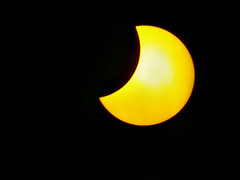 I’m back on the West Coast this week and it turns out that by coincidence while I am here there is going to be an impressive solar eclipse. Not only are solar eclipses uncommon, but when they do occur, they can only be seen from the few places on Earth where the actual path of the shadow of the moon almost completely blocks out the sun.
I’m back on the West Coast this week and it turns out that by coincidence while I am here there is going to be an impressive solar eclipse. Not only are solar eclipses uncommon, but when they do occur, they can only be seen from the few places on Earth where the actual path of the shadow of the moon almost completely blocks out the sun.
A solar eclipse of this magnitude hasn’t been seen in the United States since 1994, so there is naturally a lot of excitement about it here in California.
People throughout history have always been amazed, and often even frightened, by eclipses. Even after we no longer have apprehension over what sinister forces may be causing them, they are still amazing to see. I was fortunate enough to experience an almost-total solar eclipse some years ago while my husband and I were students at the Georgia Institute of Technology in Atlanta in the 1980s.
I have to say it was an eerie experience — it got darker and darker at midday, as if someone had put a dimmer switch on the sun. Even with the reassuring knowledge of why it was happening, I felt a little appreciation and some emotional understanding of why ancient civilizations feared the events.
But probably the most interesting thing that I remember about that day is walking under the shadow of a dense tree and seeing something I had never seen before: hundreds of miniature crescent images of light on the ground. My husband, a physicist-in-training at the time, noticed them and realized that they were actual images of the eclipse seen through thousands of little “pinhole cameras” made by the tiny gaps created randomly between the leaves in the canopy of the tree. We were both amazed, it wasn’t something we had ever heard to expect.
All of the excitement out here over the upcoming eclipse got me thinking about how impressive it really is that we can predict the path of these celestial objects. Even more so that we have been doing it for many years — predating modern technology and the advent of computers.
Babylonian astronomers thousands of years ago didn’t have accurate models of the motion of heavenly bodies, but just based on painstaking observations they were able to make some fairly accurate predictions of solar eclipses.
This also got me to thinking about change of perspective. Where once the Earth was considered the center of the universe, the change of perspective to a sun-centered “solar system” led to precise mathematical descriptions of planetary orbits by Johannes Kepler and others in the 17th century. These “laws of motion” are still taught in astronomy today to get a fundamental understanding of the orbits of planets in our solar system, or the motion of a spacecraft about the earth.
Whether we are talking about science, business, or even our personal lives sometimes a change of perspective is what is needed to shed light into the shadows, explain the unknown, and help make sense of a complex world.
